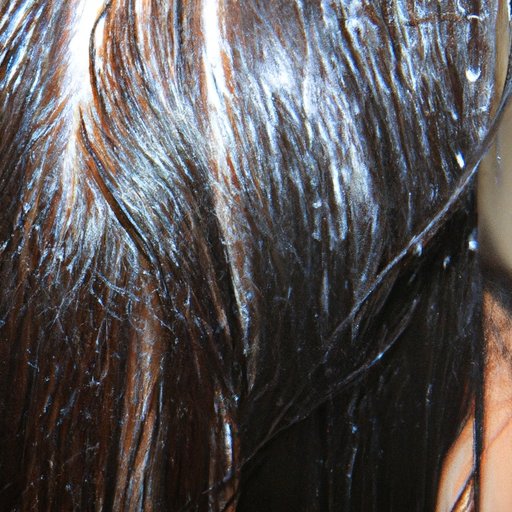
Introduction
Are you considering dyeing your hair but unsure if it’s okay to do so when your hair is wet? Perhaps you’ve heard that dyeing wet hair is the way to go, or maybe you’re unsure if dyeing dry hair will create the even results you want. Don’t worry! In this article, we will explore the truth behind dyeing wet hair and provide you with everything you need to know to achieve the perfect look for your hair.
Truth or Myth: Debunking the Idea of Dyeing Wet Hair
In order to fully understand the dos and don’ts of hair dyeing, it is important to know why it is not recommended to dye your hair when it’s wet. The science behind hair dyeing reveals that, when wet, hair fibers are more prone to damage and breakage as they absorb water, making it more difficult for the dye to penetrate the strands evenly. As a result, dyeing wet hair can lead to uneven color distribution, patchiness, and even damage.
So, can you dye your hair when it’s wet? While it is technically possible to do so, it is not recommended. In short, it’s not worth the risk! Instead, it’s best to wait until your hair is completely dry before applying hair dye.
The Dos and Don’ts of Hair Dyeing: Tips from Professional Stylists
Now that we’ve covered why dyeing wet hair is a bad idea, let’s explore the dos and don’ts of dyeing your hair, according to professional stylists.
Always start with healthy, moisturized hair. This will not only ensure an even dye job, it will help your hair to recover from the damage that dyeing can cause. Additionally, be sure to select a color that complements your natural hair color and skin tones.
When dyeing your hair, it is essential to start with dry hair. This means waiting until your hair is completely dry before applying the dye. This ensures that the dye will penetrate the hair fibers evenly and produce even color coverage. Additionally, make sure that the dye is applied evenly all over the hair, especially at the roots. You can use a professional hair coloring brush to do this, starting at the roots and working your way to the ends.
The Side Effects of Dyeing Wet Hair: What You Need to Know
As mentioned earlier, the risks of dyeing hair that is still wet far outweigh the potential benefits. When you dye wet hair, the hair fibers are swollen due to moisture, which makes them more prone to breaking and split ends.
Furthermore, due to moisture levels in wet hair, the hair color is likely to be distributed unevenly throughout the strands, resulting in patches of darker or lighter color. Additionally, the dyeing process can be more damaging to the hair, leading to unwanted side effects like hair breakage, frizz, and even diminished curl patterns.
Solving Common Dyeing Problems: How to Avoid Wet Hair Mistakes
If you’re set on coloring your hair at home, and want to avoid common mistakes that lead to uneven color distribution and damage, it’s important to properly prepare your hair for the dyeing process.
The first step is to ensure that your hair is completely dry before applying the dye. To do so, shampoo your hair and then thoroughly dry it with a towel until it’s no longer damp. However, avoid blow-drying as this will damage your hair and compromise its texture. As another step to avoid damage, be sure to apply a hair treatment or oil before dyeing your hair. This will help protect your hair from further damage and even strengthen it for future dye projects.
It’s also important to avoid D.I.Y. jobs when it comes to dyeing your hair. Instead, make an appointment with a professional stylist for a consultation to ensure that you are selecting the right color that works well with your skin tone and hair type. This consultation can also assist in guiding you toward the correct products that will not damage your hair.
The Best Time to Dye Your Hair: A Complete Guide
So what is the best time to dye your hair? Moisture is the key to healthy, strong, and vibrant strands. However, before dyeing your hair, you need to let it dry completely.
How can you know that your hair is completely dry? One indication that your hair is dry is that it is less likely to tangle, which means that the hair fibers have straightened out. Another indication is that your hair is not as heavy, but is instead light and fluffy.
Once you have determined that your hair is completely dry, you can dye your hair with the full knowledge of knowing that the dye will penetrate the strands evenly and produce the even color coverage you desire.
Conclusion
After all that has been presented, it’s clear that dyeing your wet hair may seem like a good idea, but in reality, it can lead to disastrous results. Be careful not to be misled by the “wet hair dyeing” myth, as it may leave you with uneven color distribution, hair damage, and even hair breakage. Always consult with a professional stylist to learn about the best hair dyeing practices. Properly preparing your hair for dyeing and ensuring it is completely dry are critical to achieving vibrant and healthy hair.
With the right information and techniques, you can confidently enjoy the benefits of hair dyeing without damaging your hair and without unpleasant surprises. Follow the tips and techniques presented here, and you won’t have to worry about experiencing the negative side effects of dyeing wet hair.




